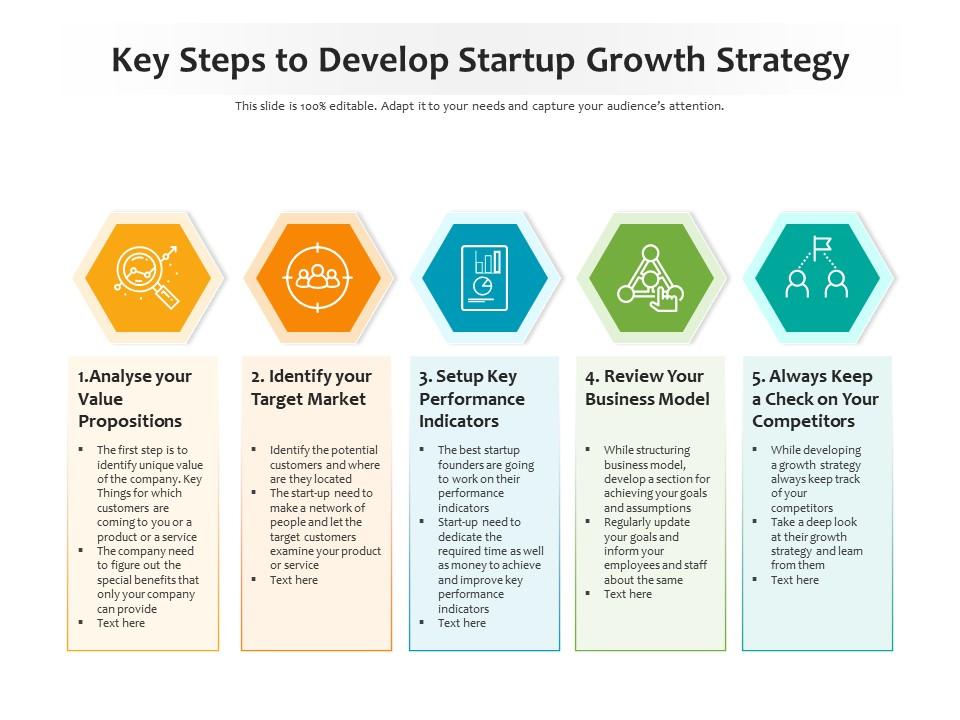Crafting a Winning Growth Strategy from the Ground Up
Developing a solid growth strategy is crucial for startups seeking to expand rapidly and sustainably. A well-crafted growth strategy serves as the foundation for a startup’s success, enabling it to navigate the complexities of the market and stay ahead of the competition. At its core, a growth strategy is a roadmap that outlines how a startup will achieve its goals, acquire new customers, and increase revenue.
A successful growth strategy begins with a deep understanding of the target audience, including their needs, preferences, and pain points. Startups must also stay attuned to market trends, monitoring shifts in consumer behavior, technological advancements, and changes in the competitive landscape. By combining these insights, startups can identify opportunities for growth and develop targeted strategies to capitalize on them.
Effective growth strategies also involve setting clear goals and objectives, establishing key performance indicators (KPIs), and allocating resources accordingly. Startups must prioritize their efforts, focusing on the most impactful initiatives that drive growth and revenue. By doing so, they can maximize their return on investment (ROI) and achieve sustainable growth over time.
Moreover, a winning growth strategy is adaptable and responsive to changing market conditions. Startups must be willing to pivot and adjust their approach as needed, incorporating new data and insights to inform their decision-making. By embracing a growth mindset and staying agile, startups can stay ahead of the curve and achieve long-term success.
Ultimately, a well-crafted growth strategy is essential for startups seeking to unlock rapid expansion and achieve their full potential. By developing a deep understanding of their target audience, staying attuned to market trends, and prioritizing impactful initiatives, startups can create a roadmap for success that drives growth, revenue, and sustainability.
How to Identify and Leverage Key Growth Channels
Identifying and prioritizing key growth channels is a crucial step in developing effective startup growth hacking strategies. Growth channels refer to the various platforms and mediums through which a startup can reach and engage with its target audience. By leveraging the right growth channels, startups can increase brand awareness, drive website traffic, and ultimately, boost revenue.
So, how do startups identify the most effective growth channels for their business? The first step is to conduct thorough market research and analyze the target audience’s behavior, preferences, and pain points. This involves gathering data on demographics, interests, and online activities to determine which channels are most likely to resonate with the target audience.
Some of the most popular growth channels for startups include social media, content marketing, and paid advertising. Social media platforms like Facebook, Twitter, and LinkedIn offer a vast array of targeting options, allowing startups to reach specific audiences with precision. Content marketing, on the other hand, involves creating and distributing valuable, relevant, and consistent content to attract and retain a clearly defined audience.
Paid advertising, including Google Ads and Facebook Ads, can also be an effective way to drive traffic and generate leads. However, startups must be strategic in their ad spend, ensuring that they are targeting the right audience with the right message. By leveraging these growth channels effectively, startups can increase their online visibility, drive conversions, and ultimately, achieve rapid expansion.
For example, Airbnb, a successful startup in the travel industry, leveraged social media and content marketing to drive growth. By creating engaging content and promoting it through social media channels, Airbnb was able to increase brand awareness, drive website traffic, and ultimately, boost bookings. Similarly, Dropbox, a cloud storage startup, used paid advertising to drive growth, targeting specific audiences with targeted ads and promotions.
By identifying and leveraging key growth channels, startups can develop effective growth hacking strategies that drive rapid expansion and revenue growth. By prioritizing the right channels and creating targeted campaigns, startups can increase their online visibility, drive conversions, and ultimately, achieve long-term success.
The Power of Data-Driven Decision Making in Growth Hacking
Data-driven decision making is a crucial aspect of startup growth hacking strategies. By leveraging data and analytics, startups can make informed decisions that drive growth, optimize resources, and maximize return on investment (ROI). In today’s digital landscape, data is abundant, and startups that fail to harness its power risk being left behind.
So, how can startups use data to inform their growth hacking decisions? The first step is to identify the right tools and platforms to collect and analyze data. Google Analytics, Mixpanel, and A/B testing are just a few examples of tools that can provide valuable insights into user behavior, conversion rates, and customer acquisition costs.
Google Analytics, for instance, provides a wealth of information on website traffic, engagement, and conversion rates. By analyzing this data, startups can identify areas of improvement, optimize their website and marketing campaigns, and increase conversions. Mixpanel, on the other hand, offers advanced analytics capabilities, including user segmentation, retention analysis, and A/B testing.
A/B testing is another powerful tool for data-driven decision making. By testing different versions of a website, email campaign, or ad creative, startups can determine which elements drive the best results and optimize their marketing efforts accordingly. This approach allows startups to make data-driven decisions, rather than relying on intuition or guesswork.
For example, HubSpot, a leading marketing and sales platform, uses data-driven decision making to optimize its growth hacking strategies. By analyzing user behavior, conversion rates, and customer acquisition costs, HubSpot can identify areas of improvement and optimize its marketing campaigns to drive growth and revenue.
By leveraging data and analytics, startups can develop effective growth hacking strategies that drive rapid expansion and revenue growth. By making data-driven decisions, startups can optimize their resources, maximize ROI, and stay ahead of the competition.
In addition to using data and analytics, startups should also prioritize experimentation and continuous learning. By testing new ideas, iterating on existing strategies, and staying up-to-date with the latest trends and best practices, startups can stay ahead of the curve and achieve long-term success.
Building a Growth Mindset: Fostering a Culture of Experimentation
Cultivating a growth mindset within a startup organization is crucial for driving innovation and experimentation. A growth mindset is a way of thinking that emphasizes the importance of learning, experimentation, and continuous improvement. By fostering a culture of experimentation, startups can encourage team members to take calculated risks, test new ideas, and learn from their mistakes.
So, how can startups build a growth mindset within their organization? The first step is to create a culture that values experimentation and learning. This involves encouraging team members to take risks, test new ideas, and share their results with the rest of the team. By doing so, startups can create a culture of continuous learning and improvement.
Another key aspect of building a growth mindset is to prioritize experimentation and testing. This involves setting aside dedicated time and resources for experimentation, and encouraging team members to test new ideas and approaches. By doing so, startups can identify new opportunities for growth and innovation, and stay ahead of the competition.
For example, Airbnb, a successful startup in the travel industry, has a strong culture of experimentation and innovation. The company encourages its team members to take risks, test new ideas, and share their results with the rest of the team. This approach has allowed Airbnb to stay ahead of the competition and drive rapid growth and innovation.
By building a growth mindset within their organization, startups can develop effective startup growth hacking strategies that drive rapid expansion and revenue growth. By prioritizing experimentation, learning, and continuous improvement, startups can stay ahead of the competition and achieve long-term success.
In addition to building a growth mindset, startups should also prioritize continuous learning and professional development. This involves providing team members with training and development opportunities, and encouraging them to stay up-to-date with the latest trends and best practices in their field. By doing so, startups can ensure that their team members have the skills and knowledge they need to drive growth and innovation.
Leveraging Influencer and Partnership Marketing for Growth
Influencer and partnership marketing can be a powerful way for startups to drive growth and expand their reach. By partnering with influencers and other businesses, startups can tap into new audiences, build brand awareness, and drive conversions. In this section, we’ll explore the potential of influencer and partnership marketing for startup growth.
One of the key benefits of influencer marketing is its ability to reach new audiences. Influencers have built large followings on social media, and by partnering with them, startups can tap into these audiences and build brand awareness. For example, a fashion startup might partner with a popular fashion influencer to showcase their products and reach a new audience.
Partnership marketing is another effective way for startups to drive growth. By partnering with other businesses, startups can expand their reach, build brand awareness, and drive conversions. For example, a startup might partner with a complementary business to offer a joint product or service, or to co-promote each other’s products.
For example, Uber and Spotify partnered to offer a joint service that allowed users to listen to music during their rides. This partnership helped to drive growth for both companies, and demonstrated the potential of partnership marketing for startup growth.
When it comes to influencer and partnership marketing, startups should focus on building relationships with influencers and partners who align with their brand values and target audience. By doing so, startups can ensure that their marketing efforts are effective and drive real results.
In addition to building relationships with influencers and partners, startups should also focus on creating high-quality content that showcases their products or services. This content can be used to promote the partnership and drive conversions, and can also be shared on social media to build brand awareness.
By leveraging influencer and partnership marketing, startups can drive growth, expand their reach, and build brand awareness. By focusing on building relationships with influencers and partners, creating high-quality content, and promoting the partnership, startups can ensure that their marketing efforts are effective and drive real results.
Optimizing User Experience for Maximum Growth
User experience (UX) plays a critical role in driving growth for startups. A well-designed UX can help to increase engagement, conversion rates, and customer satisfaction, ultimately leading to rapid expansion and revenue growth. In this section, we’ll explore the importance of UX in startup growth hacking strategies and provide tips on how to optimize UX for maximum growth.
One of the key principles of UX design is to create an intuitive and user-friendly interface. This means designing a website or application that is easy to navigate, with clear and concise language, and minimal cognitive load. By doing so, startups can reduce friction and increase the chances of conversion.
Another important aspect of UX design is to create an engaging and interactive experience. This can be achieved through the use of visuals, animations, and micro-interactions. By creating an engaging experience, startups can increase user engagement and encourage users to explore the website or application further.
For example, Airbnb’s website and mobile application are designed to provide an intuitive and engaging user experience. The website and application are easy to navigate, with clear and concise language, and minimal cognitive load. The use of high-quality visuals and animations also helps to create an engaging and interactive experience, encouraging users to explore the website and application further.
In addition to creating an intuitive and engaging experience, startups should also focus on optimizing UX for conversion. This can be achieved through the use of clear and prominent calls-to-action, minimal form fields, and streamlined checkout processes. By optimizing UX for conversion, startups can increase conversion rates and drive revenue growth.
Finally, startups should also prioritize user testing and feedback in their UX design process. This involves testing the website or application with real users, gathering feedback, and iterating on the design to improve the user experience. By prioritizing user testing and feedback, startups can ensure that their UX design is meeting the needs of their target audience and driving growth.
By optimizing UX for maximum growth, startups can increase engagement, conversion rates, and customer satisfaction, ultimately leading to rapid expansion and revenue growth. By prioritizing UX design principles, such as creating an intuitive and engaging experience, optimizing for conversion, and prioritizing user testing and feedback, startups can drive growth and achieve long-term success.
Measuring and Optimizing Growth: Key Metrics and Tools
Measuring and optimizing growth is a critical component of startup growth hacking strategies. By tracking and analyzing key metrics, startups can identify areas for improvement, optimize their growth strategies, and drive rapid expansion. In this section, we’ll outline the essential metrics and tools for measuring and optimizing growth.
One of the most important metrics for measuring growth is customer acquisition cost (CAC). CAC refers to the cost of acquiring a new customer, including marketing and sales expenses. By tracking CAC, startups can identify areas for improvement in their marketing and sales strategies and optimize their growth efforts.
Another key metric for measuring growth is retention rate. Retention rate refers to the percentage of customers who remain loyal to a startup over time. By tracking retention rate, startups can identify areas for improvement in their customer service and support strategies and optimize their growth efforts.
Return on investment (ROI) is also a critical metric for measuring growth. ROI refers to the return on investment for a startup’s marketing and sales efforts. By tracking ROI, startups can identify areas for improvement in their growth strategies and optimize their efforts.
In addition to tracking these key metrics, startups should also use tools like Google Analytics, Mixpanel, and A/B testing to measure and optimize their growth efforts. Google Analytics provides insights into website traffic, engagement, and conversion rates, while Mixpanel provides insights into user behavior and retention. A/B testing allows startups to test different versions of their website or application and identify the most effective design and functionality.
For example, a startup might use Google Analytics to track website traffic and engagement, and identify areas for improvement in their marketing and sales strategies. They might also use Mixpanel to track user behavior and retention, and identify areas for improvement in their customer service and support strategies.
By tracking and analyzing these key metrics and using tools like Google Analytics, Mixpanel, and A/B testing, startups can measure and optimize their growth efforts and drive rapid expansion. By prioritizing data-driven decision making and continuous optimization, startups can stay ahead of the competition and achieve long-term success.
In conclusion, measuring and optimizing growth is a critical component of startup growth hacking strategies. By tracking key metrics like CAC, retention rate, and ROI, and using tools like Google Analytics, Mixpanel, and A/B testing, startups can identify areas for improvement and optimize their growth efforts. By prioritizing data-driven decision making and continuous optimization, startups can drive rapid expansion and achieve long-term success.
Sustaining Growth over Time: Avoiding Plateaus and Pitfalls
Sustaining growth over time is a critical component of startup growth hacking strategies. While many startups experience rapid growth in the early stages, it’s common for growth to plateau or even decline over time. In this section, we’ll offer guidance on how to maintain momentum and avoid common growth plateaus and pitfalls.
One of the most important things to remember is to stay adaptable. As the market and competitive landscape evolve, startups must be willing to pivot and adjust their growth strategies accordingly. This might involve exploring new growth channels, adjusting marketing and sales tactics, or even shifting the company’s overall direction.
Innovating continuously is also critical for sustaining growth. Startups must continually seek out new and innovative ways to solve problems, improve products and services, and meet customer needs. This might involve investing in research and development, partnering with other companies or organizations, or even acquiring new technologies or talent.
Prioritizing customer needs is also essential for sustaining growth. Startups must continually seek out feedback from customers and use that feedback to inform product and service development, marketing and sales strategies, and overall business direction. By prioritizing customer needs, startups can build strong relationships with customers, drive loyalty and retention, and ultimately sustain growth over time.
For example, a startup might use customer feedback to inform the development of new products or services, or to adjust marketing and sales tactics to better meet customer needs. By prioritizing customer needs, startups can build strong relationships with customers and drive growth over time.
Another key thing to remember is to avoid common growth plateaus and pitfalls. For example, startups might experience a plateau in growth due to a lack of innovation, a failure to adapt to changing market conditions, or a lack of focus on customer needs. By avoiding these common pitfalls, startups can sustain growth over time and achieve long-term success.
By staying adaptable, innovating continuously, and prioritizing customer needs, startups can maintain momentum and avoid common growth plateaus and pitfalls. By following these strategies, startups can sustain growth over time and achieve long-term success.






